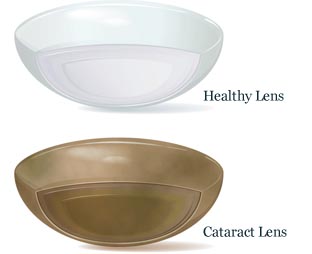About Cataracts
What Are Cataracts?
The word cataract is derived from the Greek katarraktes, which means a down rushing, or waterfall. It was originally thought that thickened brain fluid was flowing in front of the lens in the eye, obstructing clear vision. Thus the word cataract itself contributes to the continued misunderstanding of what it actually is.
Contrary to popular belief, a cataract is not a film over the eye. Rather it is a gradual thickening and hardening of the lens that causes the lens to become so clouded that light is either distorted or cannot reach the back of the eye, the retina,for transmission to the brain. See How the Eye Works.

As a result, we end up with vision that's blurry or dim as colors appear faded (with a yellowish or brownish tint). Reading or driving in low light may become difficult with cataracts as night vision fails, and halos can sometimes appear around headlights. It may even become painful to walk outside into bright sunlight and see the exaggerated glare off of reflective surfaces like windshields. Sensitivity to any bright light is one of the symptoms of a cataract.
As we age, senile miosis makes the resting size of the pupil smaller, reducing the amount of light that can enter the eye and hit the lens. If that lens has a cataract, then sight is further compromised.
There are many types of cataracts, but the majority of people develop nuclear cataracts, which are associated with extreme nearsightedness and symptoms such as blurriness and faded colors. There are also cortical cataracts, and posterior subcapsular cataracts, but they are less common with different causes.